Top 5 Hockey Shooting Simulators for 2025
Looking to improve your hockey skills off the ice? Hockey shooting simulators are the ultimate training tools for players at any level. They help you practice shooting, stickhandling, and decision-making while providing instant feedback and analytics. Here's a quick rundown of the top 5 hockey shooting simulators for 2025:
- Hockey Gyms Shooting & Stickhandling Simulator: Tracks shot accuracy, offers automated puck delivery, and includes cognitive training games. Perfect for high-volume practice (400+ shots in 30 minutes).
- Sniper's Edge Hockey Shooting Trainer: Durable and great for improving shooting accuracy and muscle memory. Ideal for home setups or training centers.
- XHockeyProducts XHockey Pro Shooting Simulator: Professional-grade system with instant feedback and online scoring. Best for elite training facilities.
- Sense Arena Hockey VR Training System: Combines VR technology with physical drills to improve reaction time and decision-making. Compact and versatile.
- SuperDeker Advanced Hockey Training System: Affordable and portable system for stickhandling and shooting drills with LED feedback and app integration.
Quick Comparison
| Simulator | Best For | Key Features | Price Range |
|---|---|---|---|
| Hockey Gyms Shooting Simulator | High-volume practice | Automated puck system, Smart Net | Custom pricing |
| Sniper's Edge Shooting Trainer | Home or training centers | Durable tarp, 5 target zones | Varies by package |
| XHockey Pro Shooting Simulator | Elite facilities | Instant feedback, online scoring | $10,800–$13,300 |
| Sense Arena VR Training System | Compact, mental training | VR drills, reaction time improvement | $59/month + VR |
| SuperDeker Training System | Affordable home training | LED targets, app integration | $349.99–$449.99 |
Whether you need a professional-grade setup or a compact home solution, there's a simulator here to match your goals and budget.
How Hockey Gyms Shooting Simulators Are Revolutionizing Ice Hockey Training
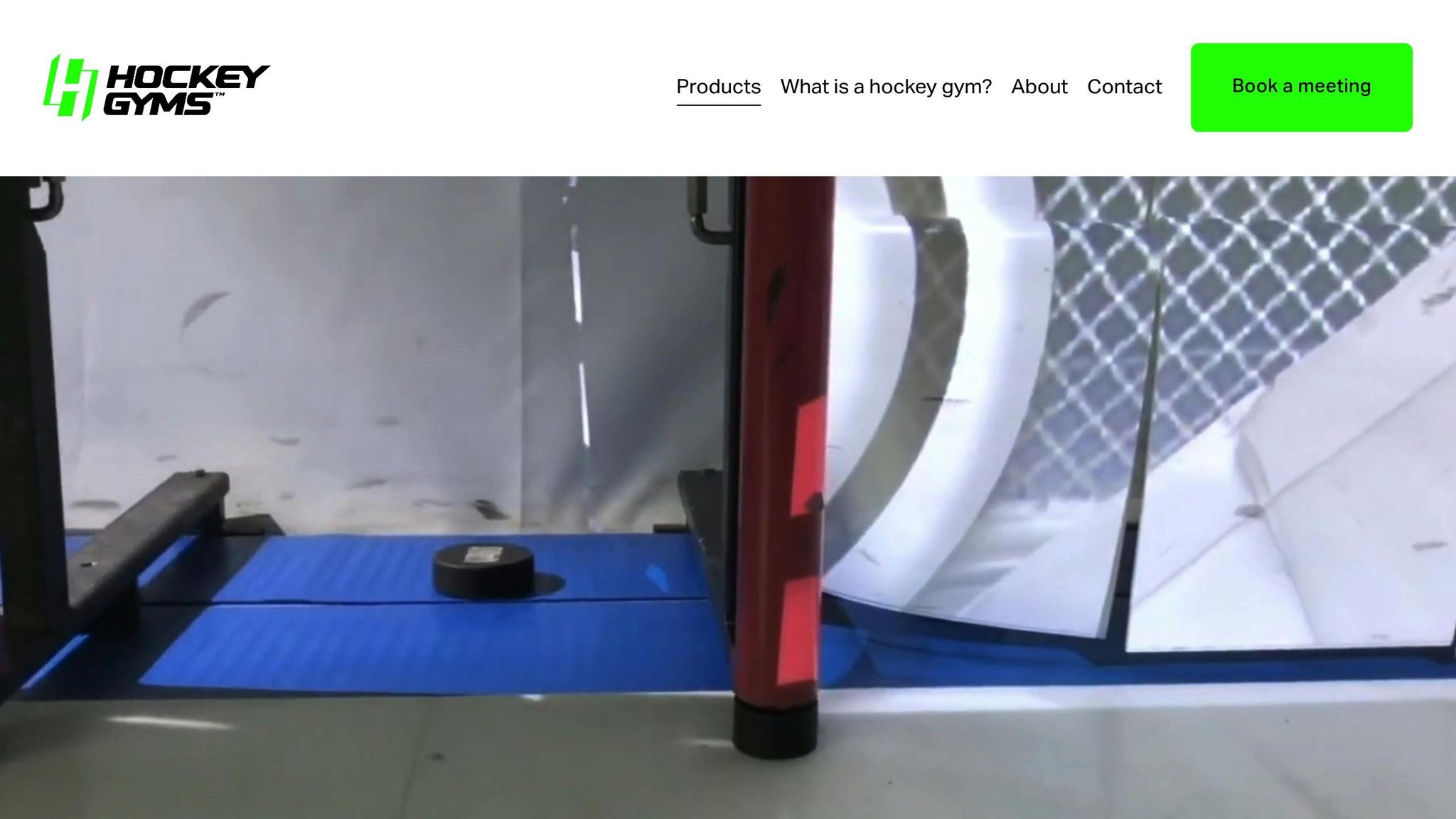

Click to watch: Hockey Gyms Shooting & Stickhandling Simulator Demo
1. Hockey Gyms Shooting & Stickhandling Simulator
The Hockey Gyms Shooting & Stickhandling Simulator transforms off-ice practice with cutting-edge motion tracking and an automated puck delivery system. The Smart Net tracks shot placement and accuracy, while the puck delivery system operates at speeds between 10 and 70 km/h (6 to 43 mph). This allows players to work on receiving passes on their forehand, backhand, or even into their skates, ensuring a well-rounded training session [1].
| Technical Specifications | Details |
|---|---|
| Space Requirements | 10' W x 32' L x 9' H per lane |
| Surface Options | Synthetic Ice, Slick Tiles, Sport Court |
| Passing Speed Range | 10-70 km/h (6-43 mph) |
| Shot Volume Capacity | 400+ shots per 30 minutes |
Some standout features include:
- Smart Net: Tracks shot accuracy and placement.
- Interactive Display: A touchscreen interface for selecting drills.
- Automated Puck System: Provides a continuous puck feed for uninterrupted practice.
- Stickhandling Template: Built-in motion sensors to refine stickhandling skills.
- Cognitive Games: Helps improve decision-making under pressure.
Installation is designed to fit various setups. It can be mounted to existing structures or installed using an aluminum cage kit. For a more modular approach, the Ozo Box standalone center is also available [1].
2. Sniper's Edge Hockey Shooting Trainer
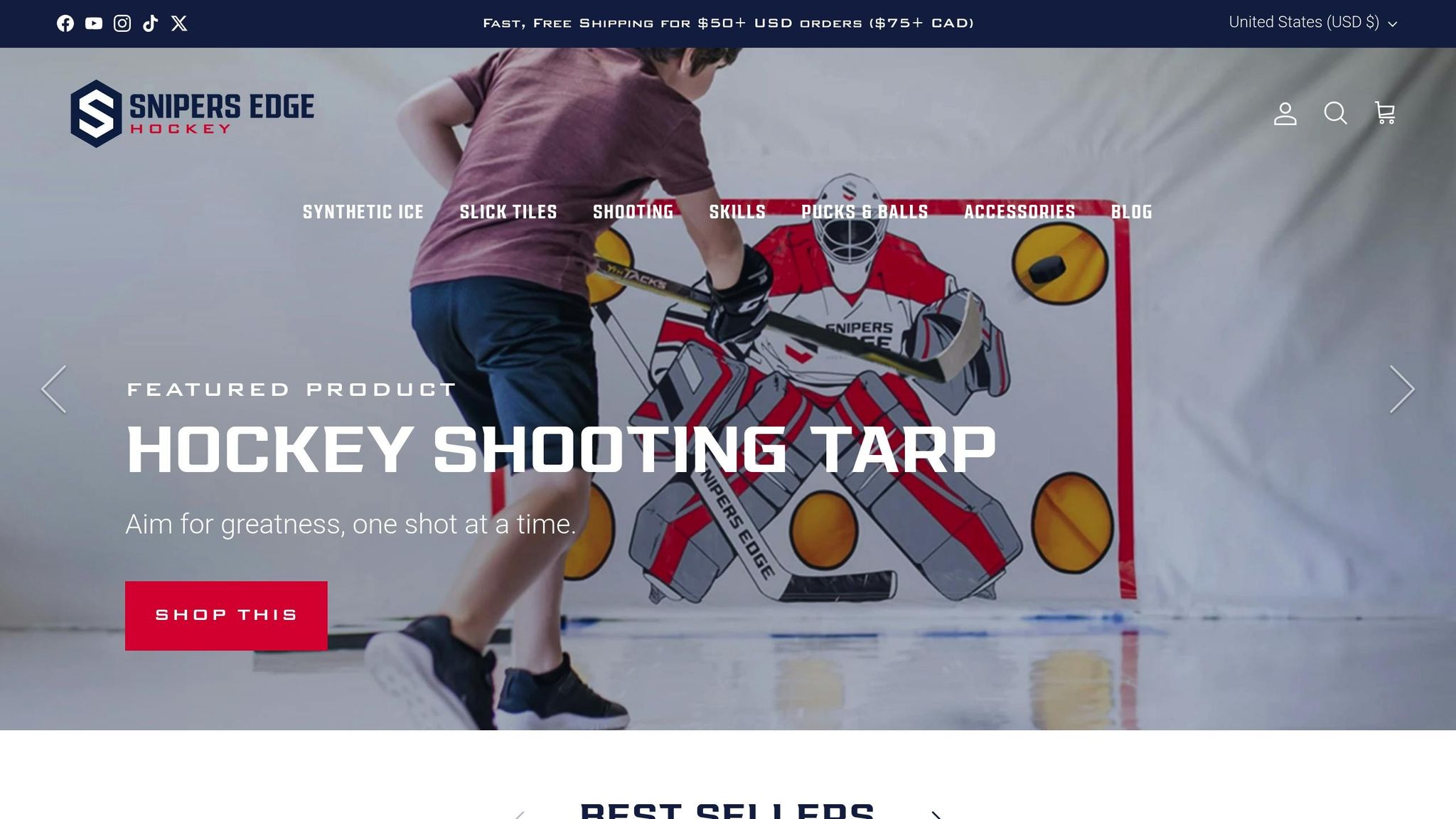
The Sniper's Edge Hockey Shooting Trainer is designed to improve shooting accuracy and hand speed, making it a great tool for both home and professional training setups.
| Feature | Specifications |
|---|---|
| Training Environment | Indoor/Outdoor, On-ice/Dryland |
| Target Areas | 5 (Upper Left/Right, Lower Left/Right, Five-Hole) |
| Installation Options | Home Setup, Training Center Mount |
| Durability Rating | Handles thousands of shots |
| Skill Level Support | Beginner to Professional |
Built with durable materials and featuring well-placed target zones, this trainer is made to handle intense use. Its shooting tarp is tough enough to endure countless pucks, as Chase Hoople from Valley Sports Academy attests:
"Our Snipers Edge shooting tarp has seen thousands of pucks in the last two years. It is VERY durable!" [2]
The trainer focuses on four key performance areas:
- Shot Accuracy: Five distinct target zones help players aim with precision.
- Quick Release: Perfect for practicing rapid-fire shots.
- Muscle Memory: Repeated drills reinforce consistent performance.
- Versatile Shooting: Encourages development of different shot techniques.
Professional hockey player John Schiavo from Best Shift Hockey Training is another advocate of Sniper's Edge:
"Simply the best training tools to develop quick hands and shooting accuracy. I use Snipers Edge products every day, and so do our coaches and athletes." [2]
To cater to different skill levels, the system comes in three packages: Rookie, Pro, and All-Star. Each package includes protective features to safeguard walls from puck impacts, making it suitable for both residential and commercial use.
Regular practice with this system helps players refine their shot accuracy and build the muscle memory needed for high-pressure game situations.
3. XHockeyProducts XHockey Pro Shooting Simulator
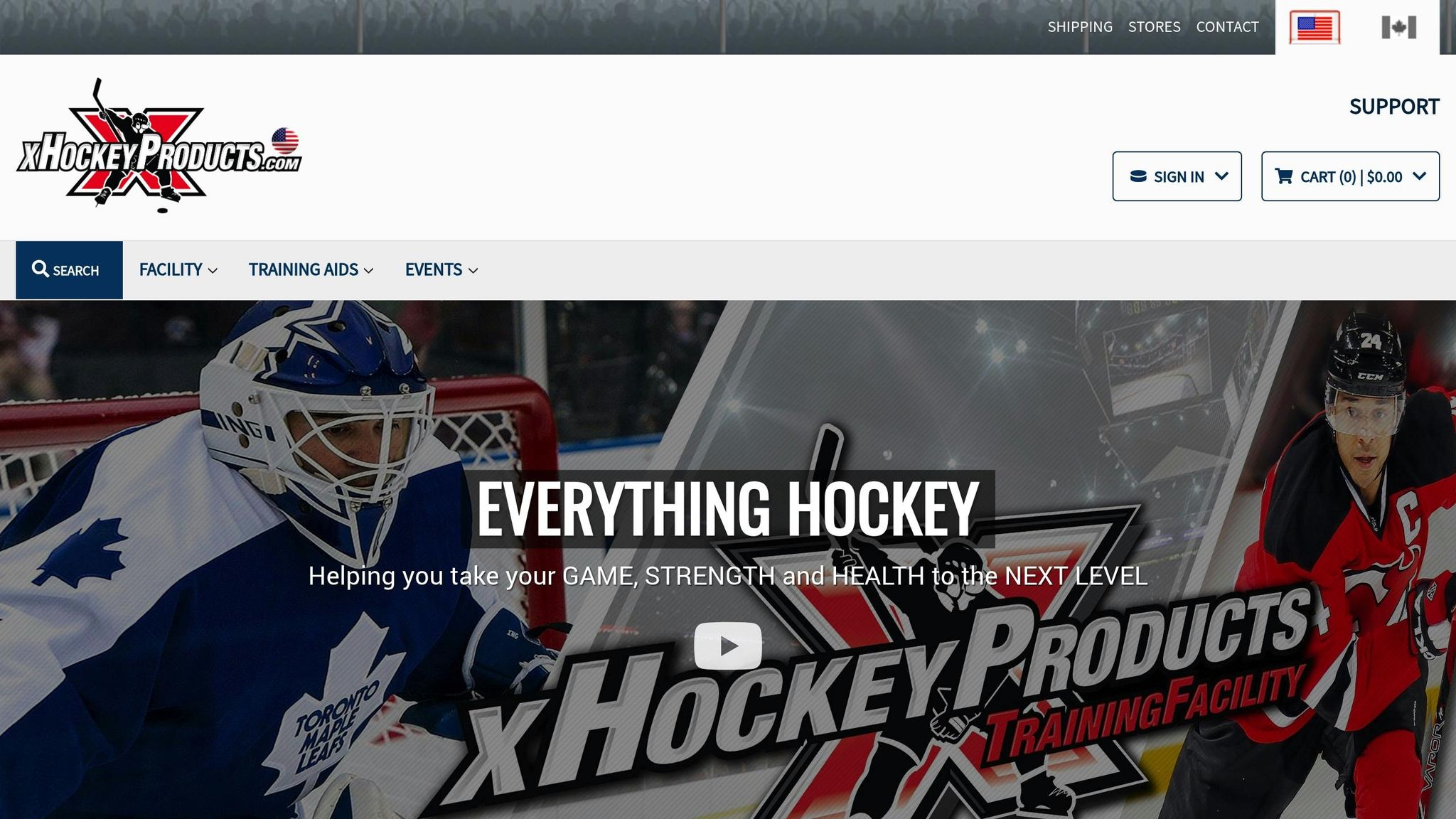
The XHockeyProducts XHockey Pro Shooting Simulator is a heavy-duty training tool built for professional hockey facilities. Weighing in at 1,200 pounds, it features advanced target sensors that instantly respond when players hit one of five key scoring zones on a regulation-size net.
| Feature | Specification |
|---|---|
| Target Zones | 5 scoring locations (regulation-size net) |
| Feedback System | Built-in target sensors with instant response |
| Display Options | Wall-mounted digital display (standard) with optional goal-frame mounted display |
| Construction | Built with durable, professional-grade materials |
| Online Integration | Tracks scores in real-time and allows players to compare results online |
This system combines precise sensors with an online scoring platform to turn ordinary practice into competitive, performance-driven sessions. Its durable construction is designed to withstand the demands of high-traffic training environments. Players can track their progress and compete with others through the connected online platform, creating a dynamic and engaging training experience.
The price ranges from $10,800.00 to $13,300.00 [3], making it a premium option for dedicated training facilities. With its sturdy design and ability to deliver instant, measurable feedback, it's a valuable tool for improving shooting accuracy and performance.
4. Sense Arena Hockey VR Training System
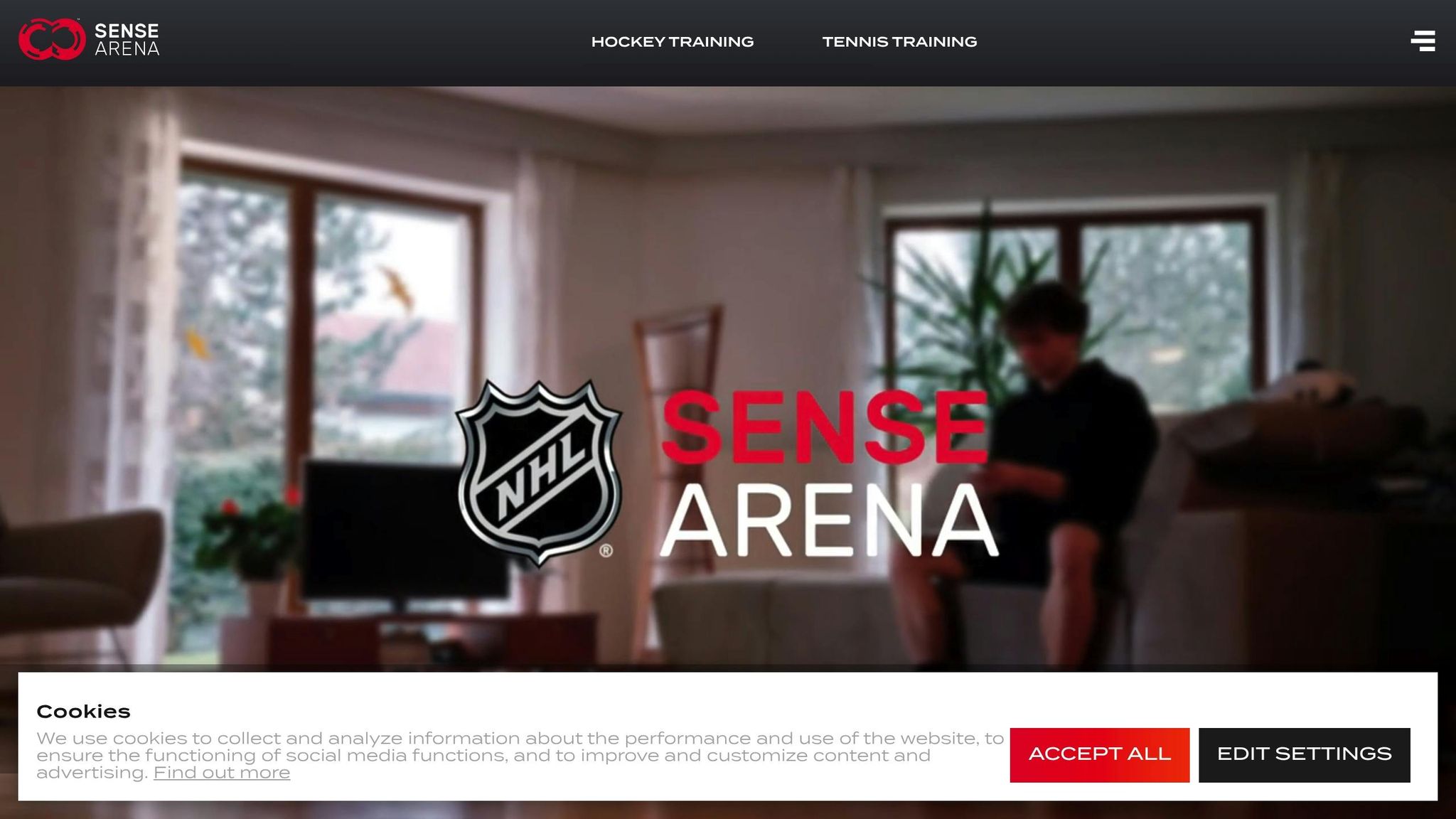
The Sense Arena Hockey VR Training System uses advanced VR technology to bring hockey training to life, turning any room into a virtual hockey rink. It combines physical drills with mental exercises to help players improve their skills.
| Feature | Details |
|---|---|
| VR Hardware | Compatible with Meta Quest 2, 3, 3s, and Pro |
| Space Needed | 6x6 ft (controllers only), 12x12 ft (with stick) |
| Subscription Cost | $59/month or $29/month (annual plan) |
| Bundle Options | Meta Quest 3S ($595) or 3 ($795) with annual plan |
| Training Areas | Shooting, reaction time, decision-making |
Players using this system have seen a 9% boost in decision-making speed and an 11% improvement in reaction time [4].
"I see NHL Sense Arena's big potential in training reflexes and reactions in the slot and around the net." - Jaromir Jagr, Rytiri Kladno [4]
This quote highlights the system's effectiveness as a training tool.
All you need is a Meta Quest VR headset and a small space. Optional controller mounts let you attach real hockey equipment, making the experience even more immersive [5].
A companion mobile app tracks your progress and provides detailed training analytics [6]. The system has delivered impressive results for goalies, including:
- +10.6% in save percentage
- +10% faster reaction time
- +9% improvement in angle positioning [8]
Designed for players aged 10 and older, it caters to both young athletes and professionals. It helps sharpen situational awareness, shot timing, and cognitive speed [7].
"NHL Sense Arena helps keep my mental game sharp in between practice sessions and games." - Devon Levi, Buffalo Sabres [4]
Though the initial investment in VR hardware and subscriptions is required, the system's compact space needs and targeted drills make it practical for both individual and team training sessions. Immediate feedback ensures every session is productive.
5. SuperDeker Advanced Hockey Training System
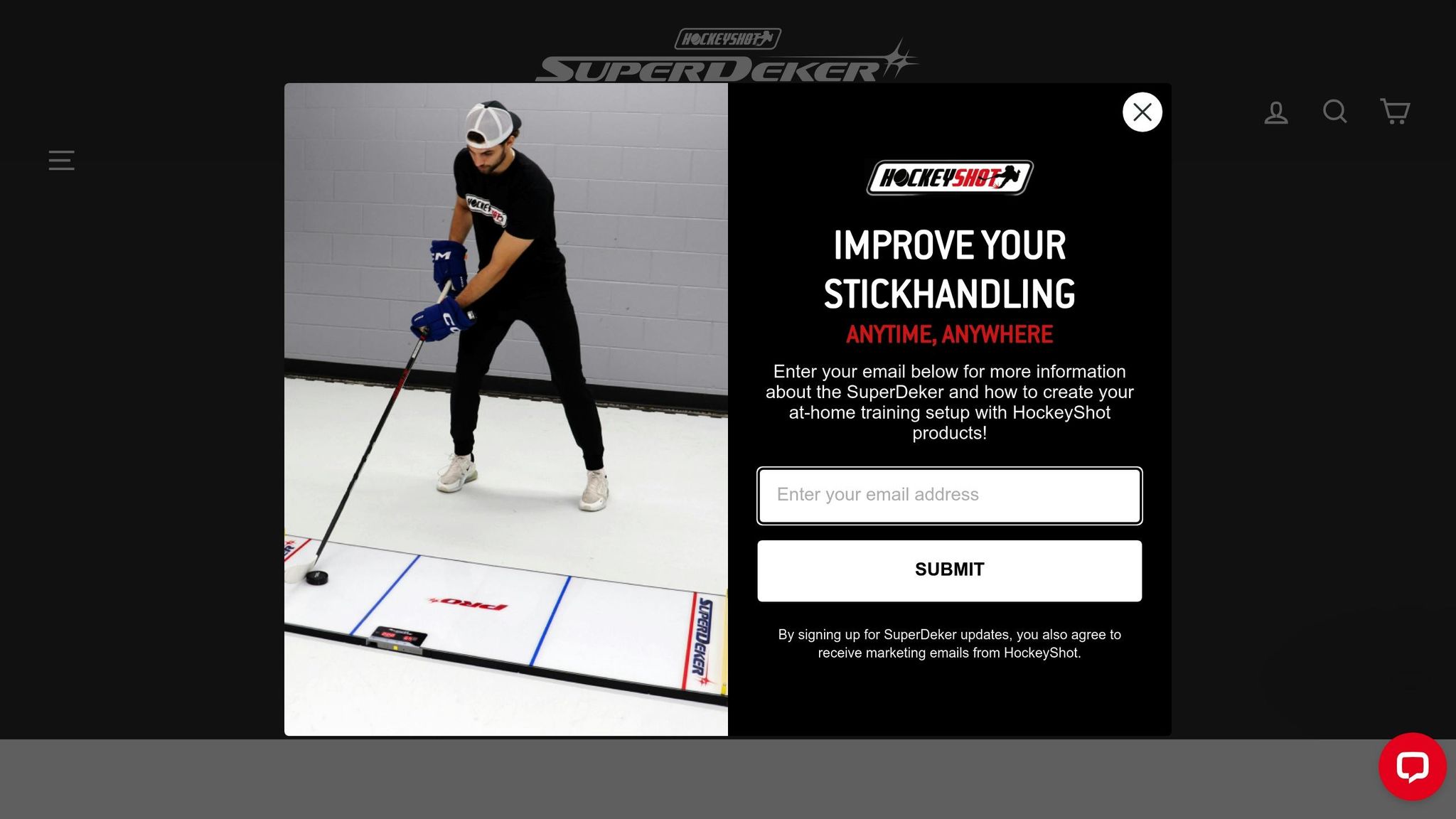
The SuperDeker Advanced Hockey Training System is designed to elevate off-ice training with its built-in sensors and low-friction polycarbonate surface. It offers realistic stick handling and shooting drills, making it a top choice for hockey players looking to sharpen their skills away from the rink.
| Feature | Details |
|---|---|
| Surface Type | Low-friction polycarbonate |
| Training Modes | Three times more options than earlier versions |
| Space Required | 2-panel (standard) or 3-panel (extended) |
| Price Options | $349.99 (2-panel), $449.99 (3-panel) |
| Tracking Method | Surface sensors with LED targets |
This system uses advanced sensors to track the ePuck, while LED targets provide instant feedback on accuracy. Paired with the SuperDeker App, users can explore various training modes and even compete on a global leaderboard.
"SuperDeker is the best off-ice training system we've seen. We use it at all of our schools to build stick handling skills, because players can't be on the ice all day. They are very popular, players are constantly lined up to use them and compete against each other." - Ty Gretzky, Founder, Gretzky Hockey School [9]
Key features include:
- A 21-Day Challenge Program with increasing difficulty levels (Bronze, Silver, Gold)
- Rebounder Bands for practicing passing
- Three game modes focusing on speed, accuracy, and passing
- Heads-up training with LED targets to improve peripheral vision
With a 4.5/5 rating from 50 reviews, SuperDeker is praised for improving stick handling and hand-eye coordination. Its customizable training modes make it suitable for players in all positions, including goalies. The companion app tracks progress and adds a competitive edge by connecting users worldwide.
How to Choose a Hockey Shooting Simulator
When selecting a hockey shooting simulator, focus on four key factors: space, training goals, technology, and budget.
Space Requirements and Installation
The size of the simulator you choose will depend on where you plan to use it. Home setups need less space, while institutional and elite systems require more room. Here's a quick guide:
| Setting Type | Minimum Space Required | Ceiling Height | Installation Type |
|---|---|---|---|
| Home Use | 10′ x 10′ | 10 feet | Self-installation options |
| Institutional | 10′ x 32′ | 9 feet | Professional installation |
| Elite Training | 11′ x 14′ | 15 feet | Professional setup |
For home use, aim for a room that's at least 10′ x 10′ x 10′. Elite systems may need up to 11′ x 14′ with a ceiling height of 15 feet [11].
Training Goals and Features
Your training objectives should guide your choice. Simulators can focus on key aspects of hockey performance:
- Shot Development: Advanced systems can help players reach milestones like:
- 70 mph wrist shots
- 0.37-second release times
- 70% shooting accuracy [10]
- Training Volume: Some systems allow players to fire over 400 pucks in just 30 minutes of practice [1].
These features are often paired with detailed analytics to track progress and identify areas for improvement.
Technology and Analytics
High-tech systems take training to the next level by providing detailed feedback. As Sean Mckenna, a former NHL player, explains:
"The capture, processing and visualization of data are at the forefront of innovation for hockey players. This system brings another level of information to players & coaches" [1].
Look for simulators that offer advanced data tracking and analysis to refine your skills.
Future-Proofing Your Investment
To stay ahead, consider systems with features like AI coaching, real-time analytics, VR integration, smart equipment compatibility, and cloud-based tracking. These tools can keep your training relevant as technology evolves.
Budget Considerations
Finally, weigh your budget against your training needs. Simulator costs vary based on features and installation requirements. Don't forget to factor in additional expenses like maintenance, subscriptions, and any necessary room modifications. Institutional-grade systems often need professional setup and upkeep, while home systems tend to be more flexible and cost-effective.
Choose a simulator that fits your space, meets your training goals, and aligns with your budget.
